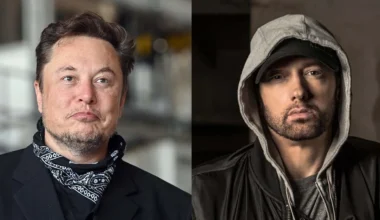At the corner of Flamingo Road and Koval Lane in Las Vegas, there’s no statue, no plaque, no official memorial. But people from across the world still travel here. Not to take selfies or tour the Strip—but to stand silently by a weathered powerline post. They come to honor Tupac Shakur, whose life was tragically cut short just feet from this very spot.
That quiet corner isn’t just a part of a city. It’s a piece of hip-hop history—because it’s where the last known photo of Tupac was taken.
One Photo, One Moment, One Legend
On the night of September 7th, 1996, Leonard Jefferson pulled up to a red light. With a camera in hand and no idea what he was about to capture, he snapped a photo. It would go on to become iconic—the final image of Tupac alive.
In that photo, Tupac sits in the passenger seat of a black BMW, his gaze piercing straight into the lens. His face is calm but intense, almost like he knew. In the driver’s seat is Suge Knight, staring forward, wearing a Coogi shirt—a brand famously tied to Tupac’s rival, Biggie Smalls.
But it’s what most people miss in this image that carries the most haunting weight.
Symbolism Woven Into His Final Hours
Tupac was wearing a green and gold sports jersey that night, but it’s the jewelry around his neck that holds deeper meaning. The medallion he wore was called “Euphanasia”—a name he created, blending euphoria (joy) with euthanasia (mercy killing). It featured an angel with wings, a halo, and a ruby teardrop on its cheek. In its hands? A weapon loaded not with bullets, but piano keys.
Inscribed on the piece: “Makaveli”—Tupac’s alter ego and a symbol of rebirth.
Strangely, the chain broke the first time it was placed around his neck. His godmother, Yasmin Fuller, helped commission the piece while Tupac was in prison, and her son Yaki Kadafi—Tupac’s close friend and fellow rapper—was with him almost every step of his life. Yet, the chain breaking was seen by some in Tupac’s circle as a bad omen.
Tupac didn’t believe in signs that night. He reattached the chain with a safety pin.
Within days, that same jewelry would be soaked in his blood.
A Chain of Tragedy
Tupac was shot just minutes after that photograph was taken. As paramedics worked desperately to save him, his chain and a matching crown ring had to be removed from his body.
He would die six days later.
But the tragedy didn’t end there.
Exactly one month after Tupac’s death, Yaki Kadafi—who was there with him in Vegas and also wore pieces from the same jewelry set—was killed. Both lives gone within weeks, both forever tied to that night, that car, and that cursed corner.
The Power of a Photograph
To most, that photo is just Tupac in a car, a few hours before his death.
But look closer.
The flash from the camera? It lines up exactly with the spot where the first bullet hit the car. The date stamp on the image? It’s wrong, distorted—as if time itself didn’t want to acknowledge what was about to happen.
That’s why the powerline post has become a shrine. It’s not about the photo. It’s about everything behind it—the symbolism, the sadness, the sense that Tupac knew his time was short.
Because sometimes, one picture tells a story more chilling than a thousand headlines.






